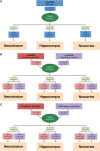The Impact of Hormonal Contraceptive Use on Serotonergic Neurotransmission and Antidepressant Treatment Response: Results From the NeuroPharm 1 Study
- PMID: 35360055
- PMCID: PMC8962375
- DOI: 10.3389/fendo.2022.799675
The Impact of Hormonal Contraceptive Use on Serotonergic Neurotransmission and Antidepressant Treatment Response: Results From the NeuroPharm 1 Study
Abstract
Background: Hormonal contraceptive (HC) use has been associated with an increased risk of developing a depressive episode. This might be related to HC's effect on the serotonergic brain system as suggested by recent cross-sectional data from our group, which show that healthy oral contraceptive (OC) users relative to non-users have lower cerebral serotonin 4 receptor (5-HT4R) levels. Here, we determine if cerebral 5-HT4R binding differs between HC non-users, OC users, and hormonal intrauterine device (HIUD) users among women with an untreated depressive episode. Also, we test if antidepressant drug treatment response and its association with pre-treatment 5-HT4R binding depends on HC status.
Methods: [11C]-SB207145 Positron Emission Tomography imaging data from the NeuroPharm-NP1 Study (NCT02869035) were available from 59 depressed premenopausal women, of which 26 used OCs and 10 used HIUDs. The participants were treated with escitalopram. Treatment response was measured as the relative change in the Hamilton Depression Rating Scale 6 items (rΔHAMD6) from baseline to week eight. Latent variable models were used to evaluate the association between global 5-HT4R binding and OC and HIUD use as well as rΔHAMD6.
Results: We found no evidence of a difference in global 5-HT4R binding between depressed HC users and non-users (p≥0.51). A significant crossover interaction (p=0.02) was observed between non-users and OC users in the association between baseline global 5-HT4R binding and week eight rΔHAMD6; OC users had 3-4% lower binding compared to non-users for every 10% percent less improvement in HAMD6. Within the groups, we observed a trend towards a positive association in non-users (padj=0.10) and a negative association in OC users (padj=0.07). We found no strong evidence of a difference in treatment response between the groups (p=0.13).
Conclusions: We found no difference in 5-HT4R binding between HC users vs. non-users in depressed women, however, it seemed that 5-HT4R settings differed qualitatively in their relation to antidepressant drug treatment response between OC users and non-users. From this we speculate that depressed OC users constitutes a special serotonin subtype of depression, which might have implications for antidepressant drug treatment response.
Keywords: [11C]SB207145; hormonal contraception; hormonal intrauterine device; major depressive disorder; oral contraception; serotonin; serotonin 4 receptor; sex steroid hormones.
Copyright © 2022 Larsen, Ozenne, Köhler-Forsberg, Poulsen, Dam, Svarer, Knudsen, Jørgensen and Frokjaer.
Conflict of interest statement
VF and GK declare to have received honorarium for advisory meetings at Sage Therapeutics, GK at Sanos, and VF for a symposium lecture at Lundbeck Pharma A/S. MJ has given talks sponsored by Boehringer Ingelheim and H. Lundbeck. The remaining authors declare that the research was conducted in the absence of any commercial or financial relationships that could be construed as a potential conflict of interest.
Figures





Similar articles
-
Oral contraceptives and the serotonin 4 receptor: a molecular brain imaging study in healthy women.Acta Psychiatr Scand. 2020 Oct;142(4):294-306. doi: 10.1111/acps.13211. Epub 2020 Jul 21. Acta Psychiatr Scand. 2020. PMID: 33314049 Free PMC article.
-
Stress Hormone Dynamics Are Coupled to Brain Serotonin 4 Receptor Availability in Unmedicated Patients With Major Depressive Disorder: A NeuroPharm Study.Int J Neuropsychopharmacol. 2023 Sep 25;26(9):639-648. doi: 10.1093/ijnp/pyad041. Int J Neuropsychopharmacol. 2023. PMID: 37542733 Free PMC article.
-
Effect of Antidepressant Treatment on 5-HT4 Receptor Binding and Associations With Clinical Outcomes and Verbal Memory in Major Depressive Disorder.Biol Psychiatry. 2025 Feb 1;97(3):261-268. doi: 10.1016/j.biopsych.2024.08.009. Epub 2024 Aug 22. Biol Psychiatry. 2025. PMID: 39181386
-
On the epidemiology of oral contraceptives and disease.Adv Cancer Res. 1987;49:285-401. doi: 10.1016/s0065-230x(08)60801-5. Adv Cancer Res. 1987. PMID: 3314396 Review.
-
Sex steroid hormones and breast cancer: is there a link with oral contraceptives and hormone replacement therapy?Med J Aust. 1992 Jan 20;156(2):124-32. Med J Aust. 1992. PMID: 1736053 Review.
Cited by
-
AI-based dimensional neuroimaging system for characterizing heterogeneity in brain structure and function in major depressive disorder: COORDINATE-MDD consortium design and rationale.BMC Psychiatry. 2023 Jan 23;23(1):59. doi: 10.1186/s12888-022-04509-7. BMC Psychiatry. 2023. PMID: 36690972 Free PMC article.
-
Loudness dependence of the auditory evoked potential: temporal stability, associations to sociodemographic variables, and functional significance-implications for clinical research.Front Hum Neurosci. 2025 Feb 6;19:1507291. doi: 10.3389/fnhum.2025.1507291. eCollection 2025. Front Hum Neurosci. 2025. PMID: 39981129 Free PMC article.
-
The historical progression of positron emission tomography research in neuroendocrinology.Front Neuroendocrinol. 2023 Jul;70:101081. doi: 10.1016/j.yfrne.2023.101081. Epub 2023 Jul 7. Front Neuroendocrinol. 2023. PMID: 37423505 Free PMC article.
-
Sexual health and serotonin 4 receptor brain binding in unmedicated patients with depression-a NeuroPharm study.Transl Psychiatry. 2023 Jul 6;13(1):247. doi: 10.1038/s41398-023-02551-x. Transl Psychiatry. 2023. PMID: 37414758 Free PMC article.
-
Current oral contraceptive use affects explicit and implicit measures of depression in women.Front Psychol. 2024 Oct 18;15:1462891. doi: 10.3389/fpsyg.2024.1462891. eCollection 2024. Front Psychol. 2024. PMID: 39492815 Free PMC article.
References
-
- United Nations . Contraceptive Use by Method 2019. UN: Data Booklet; (2019). Available at: https://www.un-ilibrary.org/content/books/9789210046527.
Publication types
MeSH terms
Substances
LinkOut - more resources
Full Text Sources
Medical

